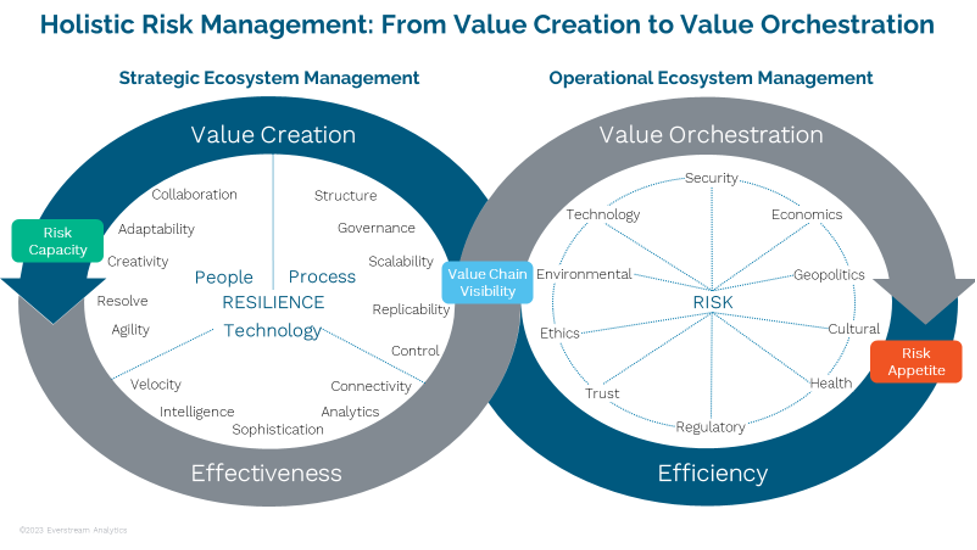
Holistic risk assessment is a multifaceted approach that seeks to understand, evaluate and manage risk across an organization. It involves creation of a vision-driven risk appetite framework for assessment and governance. Building on a set of key risk indicators, tolerances and acceptance of uncertainty, businesses can examine an array of critical changes, both apparent and hidden.
The supply chain is often considered the anchor of holistic risk assessment. It involves numerous stakeholders, processes and dependencies, exposing it to multiple risks such as natural disasters, geopolitical tensions and supplier disruptions. Holistic risk assessment is also essential for resilience, playing a key role in aligning the organization across siloes, matrixes and functions for managing risk and mitigating threats to the supply chain. It encompasses factors such as loss prevention, opportunity cost, value at risk, and risk capacity. It’s a perfect match for orchestration and management of advanced and complex supply chains. 
Advanced analytics and data integration are foundational components of holistic risk assessment. The first connects value variables, dependencies, key influencing factors and causation. The second enables enrichment, boosting accuracy and confidence directly through matching, or indirectly through correlation. Every data asset provides value, as artificial intelligence, machine learning and large language models continuously learn to reach a deeper understanding of each key risk indicator. Advanced analytics and cohesive data integration are critical for risk identification, quantification, early warning systems, scenario modeling, resource allocation, continuous monitoring and autonomous decision-making.
When the foundation is done right, holistic risk management augments critical areas of value creation and orchestration flow by the following:
Creating full-scale visibility. This is important for agility and resilience. It gives organizations real-time insights into their supply chain operations, enabling them to detect changes and potential risks and disruptions early on.
Understanding interconnected risks: Risks are rarely isolated. In risk-management exercises such as VUCA (volatility, uncertainty, complexity and ambiguity) and PESTLE (political, economic, social, technological, legal and environmental), it's critical to consider influences and causation. They often have cascading effects, where a disruption in one area can trigger a chain reaction of problems throughout the organization. Holistic risk assessment helps identify these interdependencies, and enables organizations to address root causes rather than just symptoms.
Optimizing resource allocation and risk capacity management. Organizations have finite resources for risk management, bot utilization and mitigation. By identifying and prioritizing risks through a holistic approach, they can allocate resources where they’ll have the most significant impact.
Managing globalization and complexity. Supply chains have become increasingly complex and sophisticated. Raw materials, components,and finished goods can traverse the globe multiple times through many modes of transportation and value-add activities, before reaching the end customer, then being recycled or disposed of. This complexity underscores the need for a holistic approach to risk assessment.
Maximizing customer impact. Supply chain disruptions directly impact customers. Delays, stockouts or quality issues can harm a company's reputation and customer satisfaction. It’s therefore vital to understand and manage supply chain risk.
Securing regulatory compliance and governance. Many industries face stringent regulatory requirements in their supply chain practices. Failure to meet these regulations can result in fines, legal issues, reputational damage and exclusion from markeets. A holistic approach ensures that compliance risks are addressed in the proper context, involving the right levers and stakeholders. Compliance is more than just a legal or auditing requirement.
Driving sustainability. Environmental and social factors, especially forced labor and modern-day slavery, have resulted in new legislation and enforcement globally. A holistic approach considers these requirements, ensuring that organizations manage risks proactively, in alignment with sustainability goals and expectations.
Boosting cybersecurity protection. Cybersecurity concerns have become paramount in an increasingly digital world. Supply chains rely heavily on data and information exchange through digital technologies, making them susceptible to cyber threats. Holistic risk assessment incorporates cybersecurity as a critical component in safeguarding operations and data integrity. It’s a supply chain topic as much as an IT topic.
Holistic risk assessment offers a broader, interconnected view of risk, promotes collaboration, optimizes resource allocation, and enhances an organization's ability to adapt and thrive in a complex environment. Traditional assessments, by contrast, often fail to provide the comprehensive understanding and strategic alignment that holistic risk assessment offers.
The siloed nature of many organizations can be attributed to various factors, including historical structures, a focus on functional expertise, differing incentives, poor communication, cultural barriers, leadership approaches, risk aversion and lack of digitization. It gives organizations a false sense of control, yet fails to provide the interdependencies that are necessary to addressing critical threats and opportunities. Many companies believe their risk capacity is higher than it actually is, and react to changes in demand and supply in separate verticals and markets. As a result, they fail to see the bigger picture of geopolitical and geoeconomic trends.
To address today’s challenges, organizations must prioritize strategic change, strong leadership support, cultural transformation and investment in modern technology. The last is critical to breaking down siloes and overcoming the problems that arise from decentralized and fractional organizations.
Holistic risk management requires sophisticated emerging technologies that can perform advanced analytics through generative AI, running through multiple databases and connecting insights through graph technology and unified data exchange. This enables real-time monitoring, utilization of internet-of-things sensors, and integration of blockchain-driven use cases, while helping to keep cybersecurity measures high. The new generation of leaders needs to break with the past by fostering a risk-aware culture and cross-functional collaboration. They must encourage the rapid and ethical adoption of technology, boost reliance on innovation hubs, and integrate external insights for fresh perspectives and sophisticated scenario analysis.
By prioritizing supply chain risk management within the broader context of holistic risk assessment, organizations can navigate the complex and interconnected challenges of the modern world. Those that embrace value creation and orchestration in supply chains will define markets, accelerate development of new products and standards, and embed risk management into their organizations. The winners will have tomorrow's innovations lined up, ready to hit the markets, and enjoy all the benefits of first-mover advantage.
Koray Köse is chief industry officer of Everstream Analytics.







